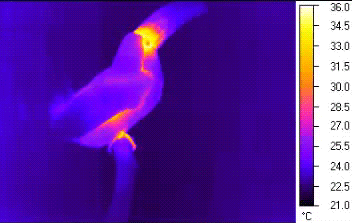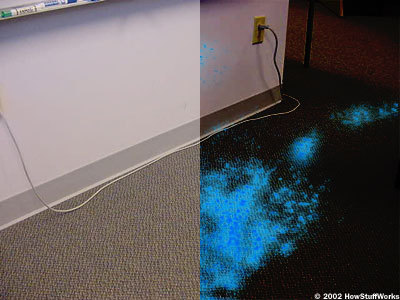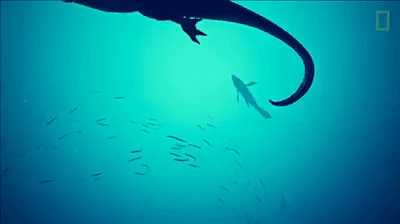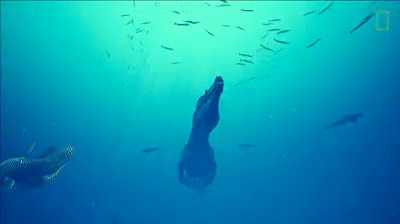This GIF Shows How The Toucan Releases Heat Using Its Beak To Cool Itself Off.

This GIF shows how the toucan releases heat using its beak to cool itself off.
The toucan beak isn’t just beautiful, it’s also an adjustable thermal radiator that the bird uses to warm and cool itself. When the bird is hot, the blood vessels in their beak open up to allow more circulation to enable heat to escape. Birds can’t sweat so evolution has come up with some life hacks to get the job done. [video]
More Posts from Theperpetualscholar and Others

Crime scene investigators are about to get a helping hand from our ancient ancestors. The earliest known synthetic pigment, Egyptian blue, is found in some of the paint on ancient statues, coffins, tomb walls, and amulets. Most other pigments long ago faded. Modern scientists, intrigued by its longevity, worked out Egyptian blue’s chemical composition decades ago. Recently it was discovered that it emits near-infrared radiation when exposed to certain kinds of light. Basically: it has rare, invisible luminescence.
And why does that help crime-stoppers? Egyptian blue can be dusted onto complicated surfaces where fingerprints are normally hard to retrieve. The surface is then photographed with a modified camera and a filter sensitive to Egyptian blue’s near-infrared rays. If fingerprints are there, they glow clearly in the resulting image. Science is amazing.


do I dare to tag toes and feet on tumblr dot com y/n?
More on birds since y’all seem to be really into birds. Transcript under the cut.
Keep reading


Luminol is a chemical that can be used to show trace amounts of blood by creating a light producing chemical reaction when mixed with hemoglobin.
Luminol powder is mixed into a liquid containing hydrogen peroxide and other chemicals. This mixture will then be sprayed over the area that is being examined.
The reaction of the Luminol spray mixing with the iron in blood will then produce a blue glow that can be seen in a dark room.
Other substances that can accidentally have the same reaction with Luminol are: bleach, urine, faeces & horseradish.
Unfortunately Luminol can destroy other crime scene evidence so it is usually used after other options have been explored.
A Few Helpful Videos
Step 1 and Done.
I don’t understand how some people can straight read First Aid and retain. Here are a few videos I found to be very helpful for understanding and memorizing concepts. With the plethora of YouTube videos out there, I feel like there should be a database of worthwhile ones somewhere (please tell me if there is already). Feel free to add any you’ve found particularly helpful.
Anatomy
Brachial Plexus Speed Drawing
Brachial Plexus Explained
General Anatomy Overview Channel
Anatomy Figure Drawings - Helps visualize muscle actions
Biostats
Watch these a couple of days before your exam for a refresher. Many of his review questions are based directly off of UWorld questions.
Practice Questions
Cardio
General Cardio Overview
JVP explained with relevant path correlations
S3/S4 - the simplest of explanations (the accent does’t hurt)
Antiarrhythmics - follow up with SketchyPharm
Antiarrhythmics - Refractory Period Explained
Embryology
This cardio video is amazing. He explains the cardio congenital defects in context of what causes each defect during development. This makes recall much easier as you’re learning the process and can work out each one even if you forget the small details. (make sure to watch both parts)
Heart Embryo Derivatives - mnemonic
Intestine Development - Overview
GI Development - Foregut, Midgut, Hindgut Orientation
Embryonic Folding
Pharyngeal Arch Mnemonic (die)
Microbiology
Algorithm/mnemonic for viruses. Pure gold.
YouTube Channels of Interest
Armando Hasudungan
Anatomy Zone
Dr. Najeeb (my hero)



New fossils suggest that spinosaurus was fully aquatic, meaning we have to re-imagine this bigger-than-T. Rex dino’s looks and behavior. Video and article from National Geographic.

Did Megalodons Brush Their Teeth In The Morning?
Almost everyone has heard about the Megaladon aka Carcharodon Megalodon - the terryfying, hair-raising sea creature that used to reign the waters about 10 million years ago. It’s a really huge scary shark basically.
And it is no secret that the species never suffered from tooth decay or plaques. Mostly this has been thought to be due to the regular changing of teeth. However, recently scientists have discovered that the sharks actually used toothpaste!
Well, not exactly. As it turns out, Megaladons had an interesting teeth mineral composition. Their teeth were packed were with fluoride, which is what we use in toothpaste nowadays. Fluoride made their teeth extremely strong and resistant to bacteria. And it wasn’t only Megaladons - most of the predator dinosaurs and several other species of sharks had a similar tooth meniralisation.
However, nowadays predators and other mammals do not boast a full set of shiny, fluoride-filled teeth. Humans themselves walk around with agonising pain in their teeth meanwhile the dentists are rolling in money. Why would evolution do such a thing? Having fluoride in your teeth seems like an awesome advantage, right?
Scientists aren’t really sure why the presence of fluoride was eliminated during the hostile course of evolution. The best guess is that the concentration of fluoride in water has decreased over the years and it wasn’t enough to support the teeth-changing cycles or organisms.
It may also be due to the fact that fluoride can be harmful. If fluoride encounters sour fruits or meat that isn’t fresh, hydrofluoric acid is formed. The acid is very corrosive, it can even dissolve glass. Who would want to have this in their mouths?
Source: http://www.paleonews.ru/index.php/new/588-fluoridtooth
-
 earlsinclair reblogged this · 3 weeks ago
earlsinclair reblogged this · 3 weeks ago -
 earlsinclair liked this · 3 weeks ago
earlsinclair liked this · 3 weeks ago -
 crabcrabcrabmeat liked this · 2 months ago
crabcrabcrabmeat liked this · 2 months ago -
 lireb-librarian liked this · 3 months ago
lireb-librarian liked this · 3 months ago -
 aweekoftodays liked this · 4 months ago
aweekoftodays liked this · 4 months ago -
 sonicgumball reblogged this · 10 months ago
sonicgumball reblogged this · 10 months ago -
 alola03 liked this · 11 months ago
alola03 liked this · 11 months ago -
 kendallnguyen36 liked this · 1 year ago
kendallnguyen36 liked this · 1 year ago -
 teanster123 reblogged this · 1 year ago
teanster123 reblogged this · 1 year ago -
 teanster123 liked this · 1 year ago
teanster123 liked this · 1 year ago -
 darkstarcocoa liked this · 1 year ago
darkstarcocoa liked this · 1 year ago -
 vela--nova reblogged this · 1 year ago
vela--nova reblogged this · 1 year ago -
 vela--nova liked this · 1 year ago
vela--nova liked this · 1 year ago -
 wander-bunnies reblogged this · 1 year ago
wander-bunnies reblogged this · 1 year ago -
 stardustspeedwaaay liked this · 1 year ago
stardustspeedwaaay liked this · 1 year ago -
 kosslowski liked this · 1 year ago
kosslowski liked this · 1 year ago -
 luinen reblogged this · 1 year ago
luinen reblogged this · 1 year ago -
 totem-kommo-o reblogged this · 1 year ago
totem-kommo-o reblogged this · 1 year ago -
 roughlyrowan reblogged this · 1 year ago
roughlyrowan reblogged this · 1 year ago -
 roughlyrowan liked this · 1 year ago
roughlyrowan liked this · 1 year ago -
 sailordee reblogged this · 1 year ago
sailordee reblogged this · 1 year ago -
 hopelessnerdybitch reblogged this · 1 year ago
hopelessnerdybitch reblogged this · 1 year ago -
 hopelessnerdybitch liked this · 1 year ago
hopelessnerdybitch liked this · 1 year ago -
 glass-clown liked this · 1 year ago
glass-clown liked this · 1 year ago -
 lbcntx liked this · 1 year ago
lbcntx liked this · 1 year ago -
 heavenly-stone liked this · 1 year ago
heavenly-stone liked this · 1 year ago -
 fortheloveofscribe reblogged this · 1 year ago
fortheloveofscribe reblogged this · 1 year ago -
 frozen-kappa reblogged this · 1 year ago
frozen-kappa reblogged this · 1 year ago -
 wyrm-o-lantern liked this · 1 year ago
wyrm-o-lantern liked this · 1 year ago -
 amplexadversary reblogged this · 1 year ago
amplexadversary reblogged this · 1 year ago -
 elderfrogboy liked this · 1 year ago
elderfrogboy liked this · 1 year ago -
 gollums-big-naturals reblogged this · 1 year ago
gollums-big-naturals reblogged this · 1 year ago -
 the-turns-have-tabled reblogged this · 1 year ago
the-turns-have-tabled reblogged this · 1 year ago -
 the-turns-have-tabled liked this · 1 year ago
the-turns-have-tabled liked this · 1 year ago -
 the-genderman reblogged this · 1 year ago
the-genderman reblogged this · 1 year ago -
 marca-espana liked this · 1 year ago
marca-espana liked this · 1 year ago -
 pastelparsec liked this · 2 years ago
pastelparsec liked this · 2 years ago -
 justarandomgreenie liked this · 2 years ago
justarandomgreenie liked this · 2 years ago -
 allthebooksandcrannies reblogged this · 2 years ago
allthebooksandcrannies reblogged this · 2 years ago -
 allthebooksandcrannies liked this · 2 years ago
allthebooksandcrannies liked this · 2 years ago -
 fandomanddenial reblogged this · 2 years ago
fandomanddenial reblogged this · 2 years ago








